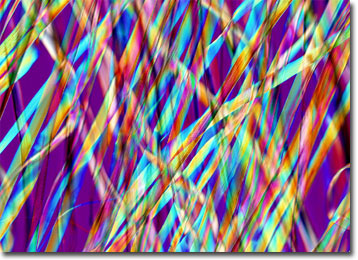Polarized Light Microscopy Digital Image Gallery
Wild Silk Fibers
Cultivated by the Chinese for thousands of years, silkworm moths are no longer found in the wild, but are instead raised in captivity around the world. These members of the genus Bombyx are commercially valuable due to the fine cocoon fibers they produce, which can be woven into luxurious fabrics.

View a second image of Wild Silk Fibers
Silkworms are tremendous eaters that consume enough food in a month to increase their body size 10,000 times its original dimensions. The diet of the caterpillars, therefore, can be quite important, often affecting the color and texture of the silk produced. Most commercial operations, therefore, keep silkworms on a restricted diet, typically consisting of mulberry leaves, in order to maintain consistency and quality of their fibers. Also, many of these same companies treat the cocoons formed by the silkworms with heat or steam in order to stop the process of metamorphosis, ensuring that the strands of silk, which may be as many as 1,000 yards long, are left intact.
A demand for organic and environmentally friendly products has inspired some entrepreneurs to concentrate on the production of what is often termed wild silk or tussah. In the production of these materials, the silkworms are allowed to live a more natural existence, feeding on all different kinds of trees and carrying out their entire life cycle. The fibers they produce fluctuate in color due to their varied diet, but are often brownish and may be difficult to bleach. Wild silk is also typically coarser than other silks because it is spun into yarns composed of many broken strands, rather than a seamless single one.
